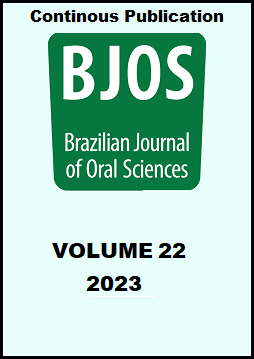Abstract
Triclosan (TCS) is a chlorinated diphenyl ether and a possible active agent against microorganisms. Due to its probability of reducing dental plaque accumulation, TCS can be added as a substance for oral hygiene. Aim: To evaluate the efficacy and antimicrobial capacity of TCS against Pseudomonas aeruginosa and Streptococcus mutans. Methods: This work evaluates the percentage of bacteria inhibition of P. aeruginosa (ATCC 27853) and S. mutans (ATCC 25175). TCS concentrations between 2 and 128 μg.mL-1 were tested. Results: An inhibitory potential of TCS was found against S. mutans. No percentage of inhibition was detected against P. aeruginosa (technical and biological triplicate). Conclusion: TCS, an antimicrobial agent used in dentifrices, can reduce S. mutans levels therefore these dentifrices should be indicated for patients with a high risk of caries. However, further study is needed, including antimicrobial analyses against other microbial conditions.
References
Paster BJ, Boches SK, Galvin JL, Ericson RE, Lau CN, Levanos VA, et al. Bacterial diversity in human subgingival plaque. J Bacteriol. 2001 Jun;183(12):3770-83. doi: 10.1128/JB.183.12.3770-3783.2001.
Forssten SD, Björklund M, Ouwehand AC. Streptococcus mutans, caries and simulation models. Nutrients. 2010 Mar;2(3):290-8. doi: 10.3390/nu2030290.
Krzyściak W, Jurczak A, Kościelniak D, Bystrowska B, Skalniak A. The virulence of Streptococcus mutans and the ability to form biofilms. Eur J Clin Microbiol Infect Dis. 2014 Apr;33(4):499-515. doi: 10.1007/s10096-013-1993-7.
Souto R, Silva-Boghossian CM, Colombo AP. Prevalence of Pseudomonas aeruginosa and Acinetobacter spp. in subgingival biofilm and saliva of subjects with chronic periodontal infection. Braz J Microbiol. 2014 Aug;45(2):495-501. doi: 10.1590/s1517-83822014000200017.
da Silva-Boghossian CM, do Souto RM, Luiz RR, Colombo AP. Association of red complex, A. actinomycetemcomitans and non-oral bacteria with periodontal diseases. Arch Oral Biol. 2011 Sep;56(9):899-906. doi: 10.1016/j.archoralbio.2011.02.009.
Lister PD, Wolter DJ, Hanson ND. Antibacterial-resistant Pseudomonas aeruginosa: clinical impact and complex regulation of chromosomally encoded resistance mechanisms. Clin Microbiol Rev. 2009 Oct;22(4):582-610. doi: 10.1128/CMR.00040-09.
Yates R, Jenkins S, Newcombe R, Wade W, Moran J, Addy M. A 6-month home usage trial of a 1% chlorhexidine toothpaste (1). Effects on plaque, gingivitis, calculus and toothstaining. J Clin Periodontol. 1993 Feb;20(2):130-8. doi: 10.1111/j.1600-051x.1993.tb00327.x.
Escalada MG, Russell AD, Maillard JY, Ochs D. Triclosan-bacteria interactions: single or multiple target sites? Lett Appl Microbiol. 2005;41(6):476-81. doi: 10.1111/j.1472-765X.2005.01790.x.
Pancer BA, Kott D, Sugai JV, Panagakos FS, Braun TM, Teles RP, et al. Effects of triclosan on host response and microbial biomarkers during experimental gingivitis. J Clin Periodontol. 2016 May;43(5):435-44. doi: 10.1111/jcpe.12519.
Blinkhorn A, Bartold PM, Cullinan MP, Madden TE, Marshall RI, Raphael SL, et al. Is there a role for triclosan/copolymer toothpaste in the management of periodontal disease? Br Dent J. 2009 Aug;207(3):117-25. doi: 10.1038/sj.bdj.2009.669.
Wallet MA, Calderon Nl, Alonso TR, Choe CS, Catalfamo Dl, Lalane CJ, et al. Triclosan alters antimicrobial and inflammatory responses of epithelial cells. Oral Dis. 2013 Apr;19(3):296-302. doi: 10.1111/odi.12001.
Bedran TB, Grignon L, Spolidorio DP, Grenier D. Subinhibitory concentrations of triclosan promote Streptococcus mutans biofilm formation and adherence to oral epithelial cells. PLoS One. 2014 Feb;9(2):e89059. doi: 10.1371/journal.pone.0089059.
MacIsaac JK, Gerona RR, Blanc PD, Apatira L, Friesen MW, Coppolino M, et al. Health care worker exposures to the antibacterial agent triclosan. J Occup Environ Med. 2014 Aug;56(8):834-9. doi: 10.1097/JOM.0000000000000183.
Mellberg JR, Blake-Haskins J, Petrou ID, Grote NE. Remineralization and demineralization in situ from a triclosan/co-polymer/fluoride dentifrice. J Dent Res. 1991 Nov;70(11):1441-3. doi: 10.1177/00220345910700110901.
Wiegand I, Hilpert K, Hancock RE. Agar and broth dilution methods to determine the minimal inhibitory concentration (MIC) of antimicrobial substances. Nat Protoc. 2008;3(2):163-75. doi: 10.1038/nprot.2007.521.
Phan TN, Marquis RE. Triclosan inhibition of membrane enzymes and glycolysis of Streptococcus mutans in suspensions and biofilms. Can J Microbiol. 2006 Oct;52(10):977-83. doi: 10.1139/w06-055.
Cullinan MP, Bird PS, Heng NC, West MJ, Seymour GJ. No evidence of triclosan-resistant bacteria following long-term use of triclosan-containing toothpaste. J Periodontal Res. 2014 Apr;49(2):220-5. doi: 10.1111/jre.12098.
Kim TO, Im DW, Jung HY, Kwon SJ, Heo YS. Purification, crystallization and preliminary X-ray diffraction analysis of enoyl-acyl carrier protein reductase (FabK) from Streptococcus mutans strain UA159. Acta Crystallogr Sect F Struct Biol Cryst Commun. 2012 Mar;68(Pt 3):292-4. doi: 10.1107/S1744309112000115.
Huang YH, Lin JS, Ma JC, Wang HH. Functional Characterization of Triclosan-Resistant Enoyl-acyl-carrier Protein Reductase (FabV) in Pseudomonas aeruginosa. Front Microbiol. 2016 Nov;7:1903. doi: 10.3389/fmicb.2016.01903.
Zhu L, Lin J, Ma J, Cronan JE, Wang H. Triclosan resistance of Pseudomonas aeruginosa PAO1 is due to FabV, a triclosan-resistant enoyl-acyl carrier protein reductase. Antimicrob Agents Chemother. 2010 Feb;54(2):689-98. doi: 10.1128/AAC.01152-09.
Monteiro MF, Tonelli H, Reis AA, Casati MZ, Silvério KG, Nociti Junior FH, et al. Triclosan toothpaste as an adjunct therapy to plaque control in children from periodontitis families: a crossover clinical trial. Clin Oral Investig. 2020 Apr;24(4):1421-30. doi: 10.1007/s00784-019-03121-6.
Pihlstrom BL, Michalowicz BS, Johnson NW. Periodontal diseases. Lancet. 2005 Nov;366(9499):1809-20. doi: 10.1016/S0140-6736(05)67728-8.

This work is licensed under a Creative Commons Attribution 4.0 International License.
Copyright (c) 2022 Jade Ormondes de Farias, Jamilca de Almeida do Espírito Santo, Ingrid Aquino Amorim, Taia Maria Berto Rezende


